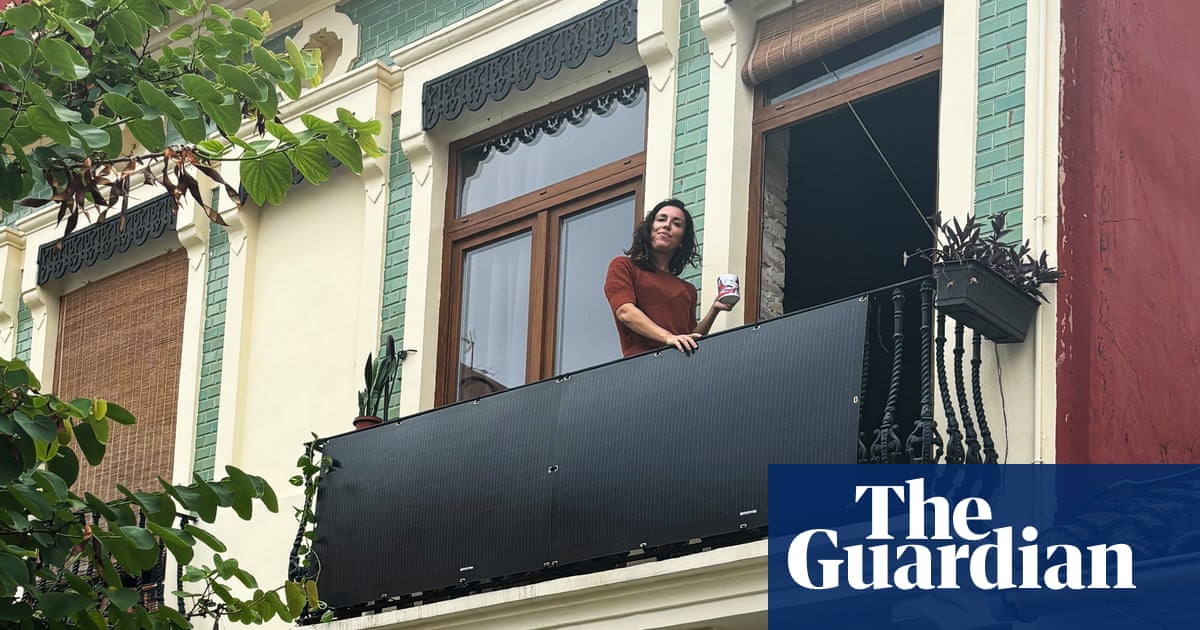Manufacturers say that installing a couple of 300-watt panels will give a saving of up to 30% on a typical household’s electricity bill. With an outlay of €400-800 and with no installation cost, the panels could pay for themselves within six years.
In Spain, where two thirds of the population live in apartments and installing panels on the roof requires the consent of a majority of the building’s residents, this DIY technology has obvious advantages.
With solar balconies, no such consent is required unless the facade is listed as of historic interest or there is a specific prohibition from the residents’ association or the local authority. Furthermore, as long as the installation does not exceed 800 watts it doesn’t require certification, which can cost from €100 to €400, depending on the area.
As with all solar power systems, balcony power only works in daylight and a battery storage system can add at least €1,000 to the installation cost.
Vernetta says the vertical surface area of cities is far greater than that of the roofs and that, in Spain, balcony panels benefit more than roof panels from the low winter sun.
Cities such as Helsinki are already experimenting with buildings with solar panel cladding.
the panels could pay for themselves within six years.
Hard pass. I don’t trust it will work in 6 years. So, it’s not really an investment.
Average solar panels are warrantied to give 100% power for 25 years. After that, they still work but at roughly an 80% rate, with a small fall off each year.
A 6 year payoff is an excellent investment. I’d gladly hang something with zero negatives on a balcony that just made me money for the rest of my life.
They don’t drop from 100% to 80% year 26. It’s a gradual but accelerating slide, with 80% still warranted at the end of the timeframe.
That doesn’t make PV a bad investment; overselling it puts people in the sceptic camp, though, which is what we’re seeing in this thread.
Its a general estimate of viability, yes. I did point out that panels drop off a bit every year, but it looks like that wasn’t clear if you feel like it needs a correction.
Every comment in here when I posted was skeptical about solar, with no stated reason. I added some general data about actual panels. If you want to add more up to date info, please do.
To be clear, I’m only wanting to clarify because I already live off solar. As such, I find it important to provide the correct information about expected panel longevity in general … getting into the weeds about things like panel type and brand tend to make people’s eyes glaze over while already skeptics, which doesn’t sell a lot of people on the virtues.
The important takeaway is, yes, this is mature tech that continues to evolve. There’s going to be loss each year, as there will be with LFP, so both can de viewed as depreciating assets when ignoring the cost savings accrued over time; however, price trends with both technologies suggest (thus far) that picking up an extra 25% of capacity in 20 years is not only doable but will actually lower the lifetime kWh cost of the system.
The real ongoing cost by then is going to be a few inverters.
If it replaced my need for a grid, I would.
It won’t, but the above replaces about 30% of power costs for life for these residents, and pays off in 6 years.
Thats still very good.
The investment is the number of less people that will die in the climate catastrophe. Stop looking at just the $$. That’s insane.
If you think this is going to help climate change at all, then you have been seriously made led by corporations trying to sell you shitty solar panels. insane is that you think a solar panel will have any microscopic impact.
1.5 m Germans using them definitely has an impact. It doesn’t solve the climate crisis on its own obviously but you can say that about any and all measures combating climate change
There is no impact. The technology just isn’t there yet. Mostly because it’s being held back by oil companies.
So, on one hand, if it becomes a profitable business, maybe it will get more support.
But on the other hand, this is just filling landfills with more junk that is designed to sell, not be a solution.
you’ve been having a minor meltdown throughout this thread to anybody who asks you basic follow-up questions. take three days off and stop it
There is no impact. The technology just isn’t there yet. Mostly because it’s being held back by oil companies.
Okay, I need a citation on that. How does big oil control solar panel technology?
Solar panels have been out for a long time, they definitely last more than 6 years. You can easily look this up.
The warranties are usually 25 years at this point.
Maybe do some research instead of using your feelings to make every decision, you’ll get a better result.
I don’t think it really matters how long the warranty is, when the manufacturer is EGHIGXXJKNB from Amazon.
Then maybe don’t buy from EGHIGXXJKNB?
Do you expect a fridge to work in six years? Seems you’re applying an unreasonable standard to solar in a vacuum.
Do you expect a fridge to work in six years?
Yes, I expect household appliances to last at least a decade. My current fridge is from 2004, and whilst it will probably need replacing soon, 20 years is not an unreasonable run.
Belgium, which outlawed plug-in solar devices over fears of having unregistered systems feeding into the grid, will lift its ban.
Why the fuck is that a fear?!?
Because back feeding the grid means the power company can’t shut the power down to work on a line. It requires coordinating everyone that might have something like this to unplug it. Rooftop installations add controllers to only supply when grid power is on, or to disconnect the house from the grid. Same thing when you add a generator inlet you’re supposed to also add a grid disconnect.
You’re sure these kits in Germany dont have that check in place? If I know Germans, it does.
I live in Germany, and I can assure you no such check exists. I have one of these systems (although I don’t plug mine into the grid, I store power in batteries and use it)
I’m not sure how the electricians protect themselves, I can only assume that they measure for voltage on the line after disconnecting from the grid, and then search for the culprits. Generally speaking any service providers inform residents well beforehand about outages, and there might be fines if you hold back work? I haven’t looked into it, perhaps someone else has more info.
The system can only feed into your house line if there is an external 230V 50Hz power net working. The moment the net goes down there will be no power from your micro inverter to your house. It requires power to work and a stable 50 Hz similar to most bigger inverters.
If you combine a power station (battery) with the inverter, this battery might give you a 230V outlet with stable 50 Hz. But this is not the one you should plug back into your house (would require an unsafe cable).
Overall, lots of fear and wrong information in this thread about safety. There is a DIN norm for all of this and the current 800W limit exists to keep your power line from melting in the walls in the most extreme cases.
‘If 1.5m Germans have them there must be something in it’
Yep, an impressive marketing campaign.
Honestly, I’m not saying they are bad. Depends on location and angle.
But the tittle is total rubbish.
30% locally generated solar power is good.
“The beauty of the solar balconies is they are flexible, cheap and plug straight into the domestic network via a converter,
How the fuck does that work??
they have a “micro inverter” you literally just plug them into a socket in your house.
that’s so dangerous…
why? they put around 600w max. there are plenty of appliances in a home that put a higher load than that.
because they backfeed into the grid, and because that means you have live male plugs.
they are not live. before they feed the grid they need to synchronize to the grid’s phase
-they detect AC from the grid
-they sync the phase to it
-start feeding








